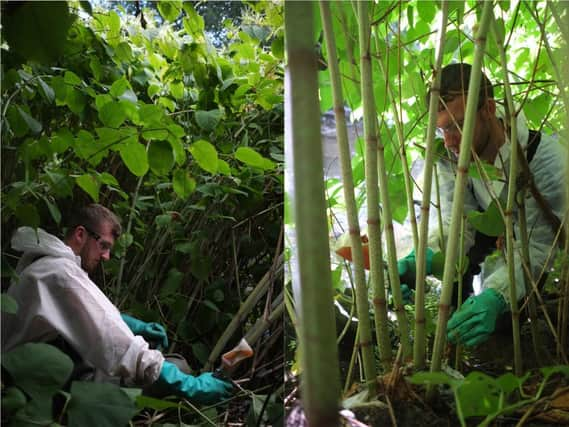How you can help to stop spread of Japanese Knotweed


They can use an app called iRecord to report any findings of the invasive species or use the online INNS Mapper tool available at ywt-data.org/inns-mapper/explore after registering.
Japanese Knotweed has a very negative impact on our environment causing the erosion of river banks increasing the risk of flooding, which is a particular problem for the Calder Valley. When it dies back in the winter months river banks are left exposed to soil erosion so rain water is unable to soak into the ground as quickly.
Advertisement
Hide AdAdvertisement
Hide AdIt is also harmful to biodiversity as it crowds our native species preventing them from growing and it can cause structural damage as it may grow through patios, conservatories and tarmac.
A campaign to tackle the problem of invasive species has been launched over the summer months in Calderdale including the Environment Agency, Calder Future, Calder Valley Clean-up Team, Calderdale Council, Yorkshire Wildlife Trust, Calder and Colne Rivers Trust, Yorkshire water, River Stewardship Company and National Trust.
On social media the organisations are spreading the word about what Japanese Knotweed looks like, why it is harmful and how to take action using #KnowAboutKnotweed.
Residents, gardeners, walkers, joggers, families, landowners and voluntary groups are being asked to help prevent the spread of Japanese Knotweed during August and September when it is in flower – last month the focus was on Himalayan Balsam.
Advertisement
Hide AdAdvertisement
Hide AdThe Yorkshire Wildlife Trust is working with landowners to help control Japanese Knotweed from the top of the catchment downstream and minimise its impact for the benefit of the community and wildlife.
Sally Kelling, flood risk adviser for the Environment Agency in Calderdale, said: “Developing a strategy to manage these invasive species is an important part of the Calderdale Action Plan which has been put together by partners to help reduce flood risk in the valley.
“Not only does Japanese Knotweed have a negative impact on the environment, it can also have an economic impact, especially to property prices.
“We are working with organisations such as Yorkshire Wildlife Trust and the River Stewardship Company to remove these species from the fringes of watercourses, starting at the top of the Calderdale catchment so that the plant does not spread downstream.
Advertisement
Hide AdAdvertisement
Hide Ad“Members of the community should not pull up Japanese Knotweed themselves as it is so easy to spread and needs professional treatment to get rid of it – however, we do need their help with identifying problem areas along the river.”
John Cave, project officer for Yorkshire Wildlife Trust, said extensive surveys carried out by their staff and volunteers, show that many parts of the Calder Valley are heavily impacted by this invasive plant.
He said: “Japanese knotweed spreads from small fragments of the stem and root along our rivers and streams. It can be very challenging to control and in many cases repeated years of treatment are needed to keep the populations at bay.
“It’s important that we work together with the local community to tackle this species effectively both now and into the future.”
Advertisement
Hide AdAdvertisement
Hide AdCouncillor Scott Patient, lead member for Climate Change, Environment & Sustainability with Calderdale Council, said: “Our campaign in Calderdale is to help members of the public to spot invasive species and raise awareness of the great harm they can do to the environment and biodiversity. If you come across Japanese Knotweed then our advice is please don’t tackle it yourself, but do let us know about it so we can use professional treatment to bring it under control.”
For further information on support available to treat Japanese Knotweed, landowners and members of the community can email [email protected]
This tall non-native plant grows to about two metres high, has large shield-shaped leaves with a stem that looks like bamboo with purple speckles. It produces clusters of white flowers in August and often grows into dense thickets. The species is commonly found in urban areas on waste ground, by the side of roads and railway lines and on riverbanks.
Introduced to this country in the early 19th century as an ornamental plant, it is now widespread across the UK and due to the problems it causes, it’s now an offence to plant it to grow in the wild.
Advertisement
Hide AdAdvertisement
Hide AdInvasive plants can be spread through soil used by people carrying out renovations or development works to their homes or gardens. It is important to make sure that that any imported soil is certified to be clean of hazardous material including any minute pieces of invasive plant species such as Japanese knotweed. Any material contaminated with invasive plant material must be disposed of at a licenced site not through council refuse collections.
For more information about invasive species and the action being taken in Calderdale visit eyeoncalderdale.com/invasive-species